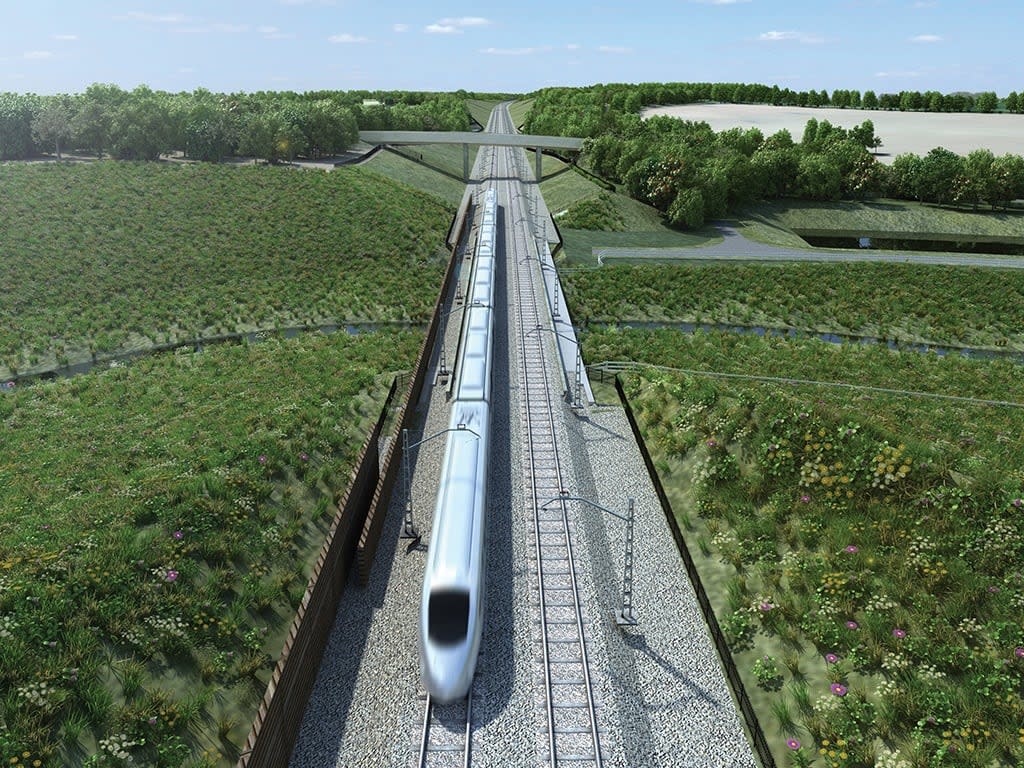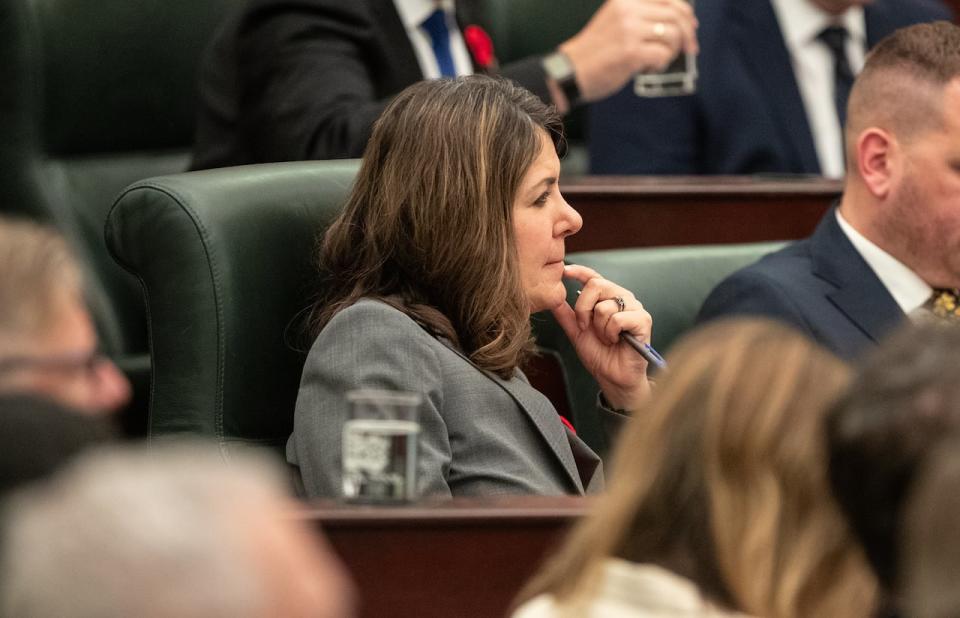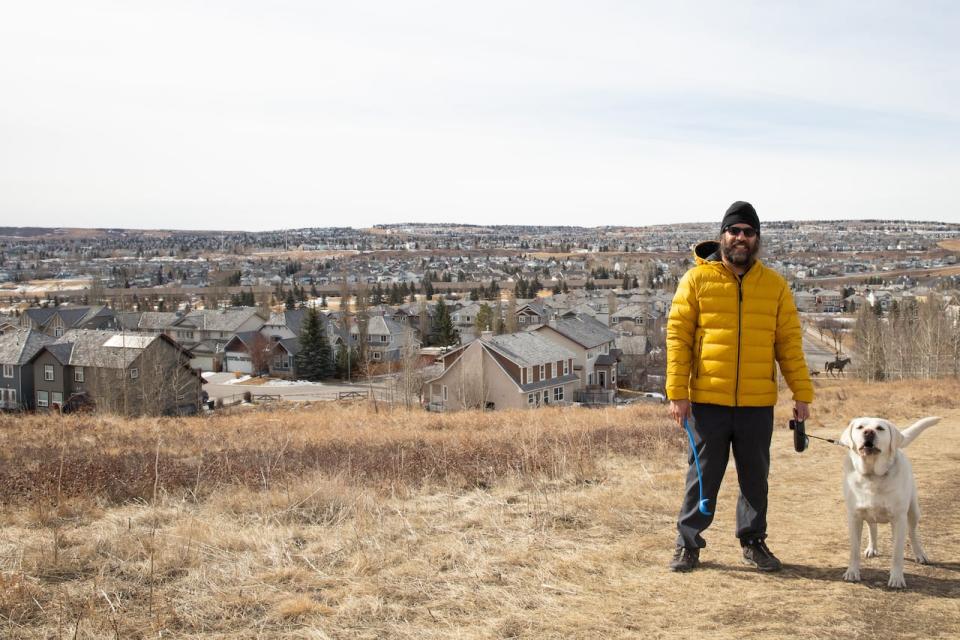All aboard Danielle Smith's bullet train to never-ending Alberta super-growth

Better make room for more neighbours, Albertans. So many more.
If the premier has it right, the province's population is on track to more than double in the time it will take my three-year-old to turn 30.
And in this mid-century, 10-million-person future of Smith's telling, you can take trains from Banff to Calgary and then at high-speed onto Edmonton; we'll still get most of our power from natural gas yet also reach net-zero emissions, as the "greenest energy producer in the world"; our taxes will be remain rock bottom and our public services will be world class.
This sketch of Tomorrowland, Alta., comes in this week's provincial throne speech.
By design, these speeches offer an outlook through rose-coloured glasses — every province is world class and "the very best Canada has to offer" according to its respective throne speech — but the one Smith's speechwriters gave Lt.-Gov. Salma Lakhani to read is something more.
Extra-sparkly-rosy? Well, to try another metaphor, it's certainly bullish in asserting the province's population will outstrip British Columbia and Québec by 2050.
To be sure, Alberta's currently growing at a current clip not seen since 1981, having grown by a staggering 184,400 in the last year to hit 4.7 million.
5,300,000 to go
The throne speech, however, projects that pace to continue unabated.
"As we surpass five million people in the coming 24 months, Alberta's government must set priorities and guide its work through the lens of understanding that by 2050, our province is projected to be the second largest in the country with a population approaching 10 million people," the speech states.
It's not clear where this growth estimate came from, because the premier's office didn't respond to a query Monday.
It could be that somebody just added 184,400 to Alberta's population every year through 2050. It's certainly not the government's own forecasts, which back in July projected Alberta to have 7.1 million people by 2051 — or 8.6 million in its "high" scenario.
Nor is it clear how it's posited that the province will surpass British Columbia, a province that is currently 17 per cent more populous, or Québec and its 8.9 million current residents, according to the latest Statistics Canada estimate. That agency doesn't think Alberta's outgrowing either province in its forecast, while Québec projects it will also nearly hit 10 million by 2050, with a lot less growing needed for it to get there.

Premier Danielle Smith listens to a throne speech that twice suggests a 10-million-person Alberta by 2050. (THE CANADIAN PRESS)
But according to this legislature-opening address, this new reality of boundless ultra-growth is the reality Smith believes her government should plan toward.
It's within that frame of mind that Smith referred to not one but two oft-discussed rail projects: a train from Banff to Calgary's downtown and airport, and that perennial dream of a high-speed link between Alberta's two biggest cities.
"And yes, we need to start planning for the inevitable need for high-speed rail through the Calgary-Red Deer-Edmonton corridor when six to seven million Albertans eventually call that corridor their home," the speech stated, its "and yes" perhaps showing awareness of the endless cycle of feasibility studies that keep putting off a transport idea that not even the Québec-Ontario corridor has achieved yet.
The last provincial study in 2014 concluded it wasn't a good idea, with ridership not even making it a good investment by mid-century. But a 10-million-person province wasn't envisioned in that report.
"When you have that kind of population, it all of a sudden becomes economic," Smith told reporters. She didn't say what planning work is next; a private company's 2021 proposal for a $9-billion line remains alive, its proponents told CBC News on Monday.
If Alberta seriously believes its population will somehow more than double in 27 years, choo-choos will be a lesser construction concern. We'd also have to likely double our housing stock by then too, from the current 1.8 million. That makes the province's throne-speech boast that it will support development of 25,000 more units by 2031 seem like a drop in the rose-coloured bucket.

Just think of how many homes Alberta would need to build to contain more than 5 million additional people in 27 years. (Ose Irete/CBC)
The year 2050, of course, has become an auspicious target year for Canada and Alberta — when both governments are proposing we can reach net-zero to help keep climate change in check.
Mass electrification of vehicles and heating are already expected to require a massive build-out of Alberta's power-generating capacity, even without five million more Albertans to serve.
Smith has signalled she's determined to expand the provincial fleet of natural gas generators — to prevent that more gloomy prediction she's made lately of frequent blackouts if federal clean-electricity goals are to be forced upon Alberta.
But with no private businesses vying to propose new plants right now, the premier indicated on Monday a willingness to bring government support to the generation market: "Whatever it takes to get natural gas plants built," she said, without offering specifics.
With all the headwinds facing Alberta's oil and natural gas industries, Alberta's throne speech offered another confident prediction: "Alberta's government will ensure the entire world understands that the words 'Alberta' and 'energy' are inextricably linked for generations."
It should go without saying that the future's hard to predict — the recent pace of post-pandemic growth in Canada and Alberta took demographers by surprise.
Alberta has managed to double its population since 1986 — in 37 years — so maybe this 10-million vision is possible?
But you don't have to live in Alberta multiple generations to recognize its volatility, and all the booms and busts that prudent provincial leaders would consider, and all the risks to prepare for.
Once a boomtown
Let's take a sober gander at decade-old forecasts for Fort McMurray.
In 2014, right before the Wood Buffalo region's census put its population at 125,032, a major planning study said it would keep on charging as oilsands production ballooned, on to 160,000 people by the start of this decade. This was before recession hit, and the cataclysmic wildfire; the last population count in 2021 for Fort McMurray and region was only 106,059.
As the oilsands capital continued its seemingly interminable rise, the Fort McMurray airport spent $258 million on replacing its undersized old terminal with a new facility five times its size. Randy Bachman and Fred Turner played "You Ain't Seen Nothing Yet" at its grand opening, while airport leaders plotted another costly expansion right on its heels.
That terminal was built to welcome 1.5 million yearly passengers; in 2016, airport traffic fell below half that mark and kept sinking, down to 320,319 last year, airport statistics show.
A high-speed rail link between Calgary and Edmonton could become a white elephant, or it could be the green, sensible way to get between cities, as they are in much of the world. Alberta could still be burning fossil fuel to power homes in a net-zero world, and maybe the United Conservatives are not just at the start of Alberta's next multi-generation political dynasty, and some Gen-Z teen will be its premier in 2050.
Or maybe not. Figuring this out perfectly now is a low-odds proposition, something like one in 10 million.


